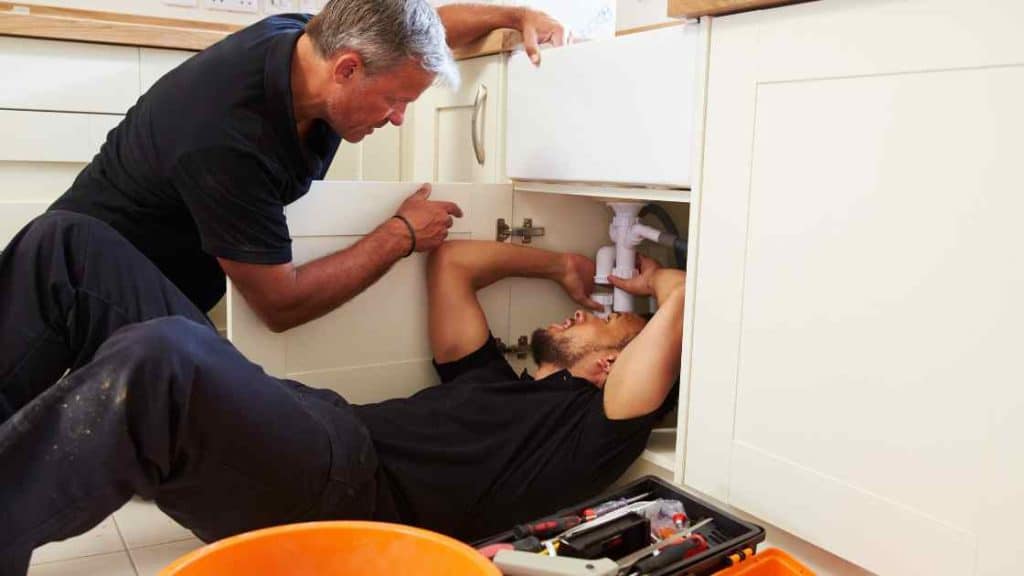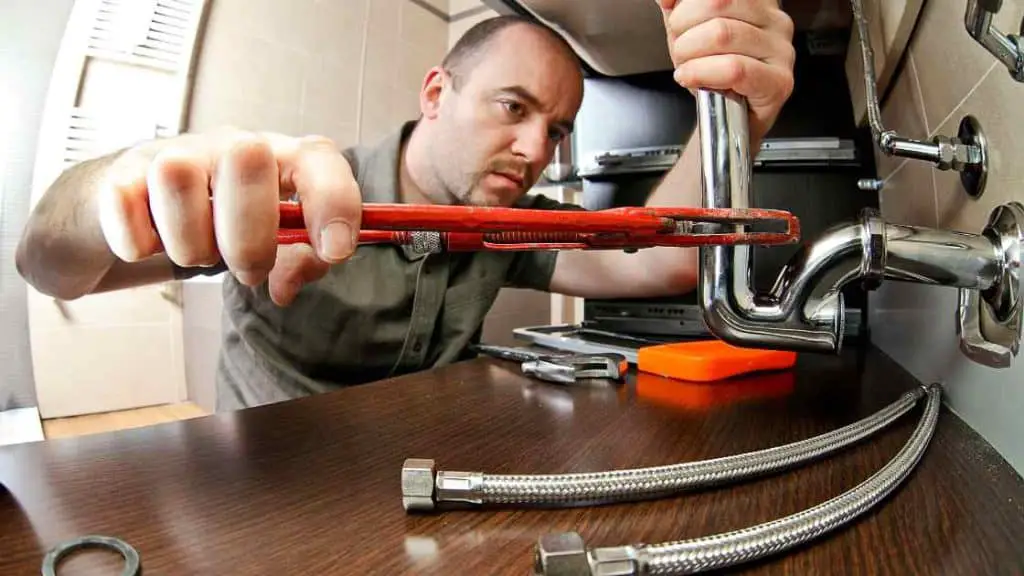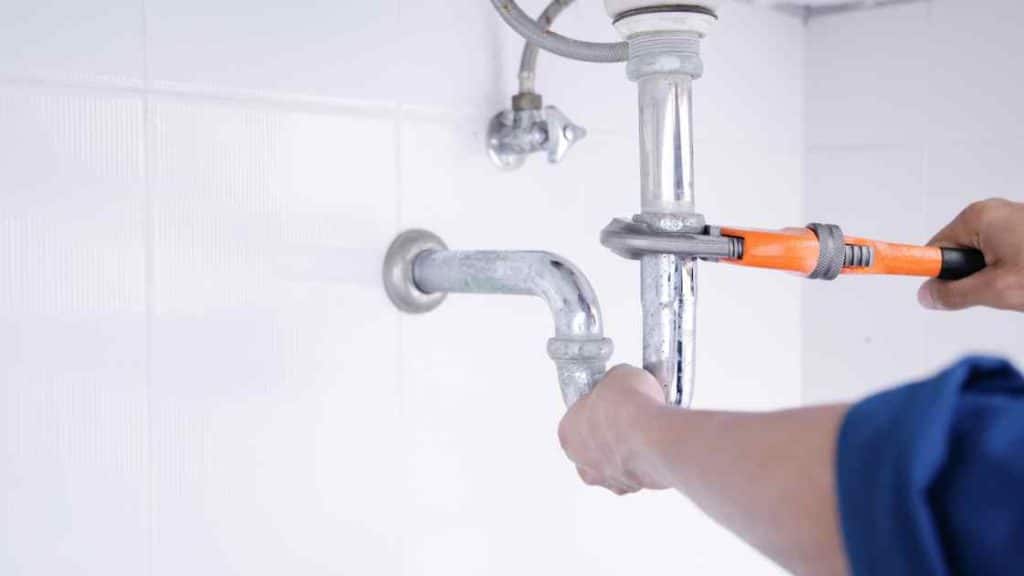Common kitchen sink plumbing problems include clogged drains and leaky faucets. These issues can disrupt daily kitchen routines and may require professional repairs.
Dealing with kitchen sink plumbing can often feel daunting as it is an integral part of our daily lives, involving everything from dishwashing to food preparation. Clogged drains, caused by the accumulation of food particles, grease, and debris, are among the most frequent headaches for homeowners.
Leaky faucets, on the other hand, can lead to water waste and increased utility bills if not addressed promptly. Regular maintenance and proper disposal habits can prevent such problems, yet sometimes the complexity of plumbing systems calls for expert intervention.
The symptoms early, like slow drainage or a dripping tap, allow for quicker solutions, ensuring the kitchen remains a functional and stress-free space.

Awareness Kitchen Sink Plumbing
Clogged drains or leaky faucets often mean kitchen sink plumbing issues. Knowing how your sink works can save time and money. We’ll explore the sink plumbing system, explaining each part’s role.
Anatomy Of A Kitchen Sink Plumbing System
The kitchen sink’s anatomy involves pipes and fixtures. Water comes in through supply lines. It then goes down the drain, through the trap, and out the waste line. Recognize these parts for quick fixes.
- Faucet: Controls water flow.
- Handles: Adjust cold and hot water.
- Supply Lines: Deliver water to the faucet.
- Drain: Where water exits the sink.
- P-Trap: Curved pipe preventing odors.
- Waste Line: Carries water away.
The Role Of Venting In Sink Plumbing
Proper venting keeps water flowing smoothly. It balances air pressure in the pipes. Without vents, drains may gurgle or slow. Proper venting prevents these problems.
Common Materials Used In Sink Plumbing
Kitchen sinks use various materials. Pipes can be copper, PVC, or stainless steel. Faucets and handles often come in brass or chrome. Select durable materials to minimize issues.
| Material | Uses | Pros |
|---|---|---|
| Copper | Pipes | Durable |
| PVC | Pipes, Traps | Lightweight, Easy to install |
| Stainless Steel | Sinks | Resists corrosion |
| Brass | Faucets | Long-lasting |
| Chrome | Finishes | Shiny, Aesthetic |
Preventive Measures For Sink Plumbing Care

The heart of any kitchen beats at the sink, where we clean our dishes, prepare food, and often dump waste. But a clogged or broken sink can bring all that activity to a screeching halt.
Regular upkeep can spare homeowners the headache and costs associated with plumbing problems. Let’s explore some straightforward, smart strategies to keep the kitchen sink in tip-top shape.
Regular Maintenance Tips
Maintaining your kitchen sink might sound daunting, but it’s easier than it seems. Just a few simple habits can make a big difference:
- Inspect the sink regularly for any early signs of leaks or drips.
- Give the sink a good clean weekly to prevent build-up.
- Run hot water after use to clear the pipes.
Proper Disposal Practices To Avoid Clogs
To ensure a clog-free sink, watch what goes down the drain. Teach your family these smart practices:
- Avoid dumping oil, grease, and coffee grounds.
- Scrape off food scraps into the bin, not the sink.
- Use a mix of baking soda and vinegar monthly to break down possible blockages.
Using Strainers And Garbage Disposals Wisely
Simple tools like strainers can go a long way in preventing plumbing woes:
- Place a strainer in the sink to catch solids.
- Clean the strainer regularly for free flow.
And for those with a garbage disposal:
- Use cold water when grinding food waste.
- Grind citrus rinds to freshen up the drain.
Common Sink Plumbing Issues
Your kitchen sink is pivotal to daily chores, yet plumbing issues often interrupt the flow of your home life. A clogged drain, a leaky faucet, or low water pressure are not just inconveniences—they signal the need for immediate attention. These common problems ensure a swift return to normalcy.
Clogged Drain: Causes And Solutions
Clogged drains disrupt your kitchen’s functionality. The culprit is often a buildup of food particles, grease, or foreign objects.
- Causes:
- Accumulation of food scraps
- Hardened grease or oils
- Non-dissolvable items like rice or pasta
Solutions: Begin with a plunger. If unsuccessful, try a mixture of baking soda and vinegar. For stubborn clogs, a plumber’s snake or professional help may be needed.
Leaky Faucet And Pipes: Identifying And Fixing
Drips from a leaky faucet can waste water and increase bills. Worn-out washers or o-rings often cause leaks.
Identifying: Inspect the faucet for worn components. Look under the sink for water spots, mold, or bad odors.
Fixing: Replace damaged washers or o-rings. Seal pipe connections with the plumber’s tape. Tighten loose fittings. Contact a professional for complex leaks.
Low Water Pressure: Diagnosing The Problem
Low water pressure affects cleaning efficiency. Mineral deposits or pipe blockages are common issues.
| Causes | Diagnosis |
|---|---|
| Mineral buildup | Clean the aerator or replace it. |
| Leaking pipes | Examine for leaks and repair or replace pipes. |
For persistent low pressure, involve a plumber to investigate the main water supply.
Advanced Plumbing Problems

Kitchen sinks may seem straightforward until advanced plumbing problems arise. These hidden issues can cause headaches and high repair bills if not addressed promptly.
Corroded Pipes: Signs And Prevention
Corrosion in pipes sneaks up over time. Signs include:
- Discolored water, raising safety concerns
- Leaks that damage cabinets and floors
- Reduced water pressure, frustrating homeowners
To prevent corrosion:
- Regularly inspect pipes for signs of trouble
- Install water softeners in hard water areas
- Maintain a balanced pH in your water
Sewer Gas Odors: Awareness The Causes
Foul odors should never waft from your sink. The culprits are often:
- Dry P-traps, easily fixed by running water
- Drain vents blocked by nests or leaves
- Cracked sewer lines need professional repair
Kitchen routine checks prevent these smelly surprises.
Persistent Clogging: What’s Happening?
Clogs that keep coming back often hide deeper issues. These include:
- Grease buildup deep in the system
- Tree roots intruding into sewer lines
- Foreign objects lodged in the pipes
A thorough plumbing check can identify these stubborn clogs.
Diy Troubleshooting And Repairs
Encountering a kitchen sink plumbing problem can dampen anyone’s day. But with the right tools and a bit of know-how, tackling common issues like clogs and leaks is possible.
Below are the essentials for any DIY plumbing repair, detailed steps for unclogging your kitchen sink, and tips for fixing leaks.
Tools And Essentials For Diy Fixes
Facing a plumbing issue requires the right set of tools. Start with these basics:
-
- Plunger: A must-have for dislodging clogs
- Wrenches and Pliers: For tightening and loosening fittings
- Plumber’s Tape: Essential for sealing thread connections
- Drain Snake: Great for stubborn blockages
- Bucket: To catch drips or hold tools
Step-by-step Guide To Unclogging A Sink
-
-
-
- Clear the Area: Remove dishes and standing water.
- Plunge Away: Firmly press the plunger over the drain and pump.
- Check the P-Trap: Place a bucket underneath, then unscrew and clean it.
- Use a Drain Snake: Insert the snake into the drain and turn it.
- Flush with Hot Water: Run hot water to clear the remaining debris.
-
-
Repairing Common Leaks Yourself
Leaks can come from faucets, connections, or under the sink. Here’s a simple guide:
-
-
- Identify the Leak Source: Wipe everything dry and watch for drips.
- Tighten Connections: Use pliers or a wrench to snug fittings.
- Replace Washers and Gaskets: These often cause leaks when worn out.
- Apply Plumber’s Tape: Wrap around threads to seal connections.
- Test Your Fix: Turn the water on and check for dripping.
-
When To Call A Professional Plumber

Plumbing woes with kitchen sinks can quickly escalate from a minor nuisance to a full-blown crisis. Awareness of when to engage a professional plumber is crucial to maintaining the integrity of your home’s plumbing system and avoiding costly damages.
Limitations Of Diy Plumbing
Embarking on DIY sink repairs might seem cost-effective but certain limitations exist. Inadequate expertise and wrong tools often lead to bigger issues than the original problem.
- Voided warranties: Unprofessional fixes may nullify manufacturer warranties.
- Risk of damage: Accidental damage to pipes or fixtures can be expensive.
- Safety concerns: Mishandling tools or materials could pose personal injury risks.
Recognizing Complex Plumbing Issues
Some plumbing issues surpass simple fixes and require a professional’s attention. Recognizing these complexities is key to averting plumbing catastrophes.
| Issue | Professional Needed? |
|---|---|
| Leaky Pipes | Yes, to prevent water damage. |
| Clogged Drains | Yes, if recurrent or severe. |
| Poor Water Pressure | Yes, could indicate supply issues. |
The Long-term Benefits Of Professional Repairs
Entrusting a licensed plumber with your kitchen sink issues offers numerous long-term benefits. Professionals ensure quality repairs that stand the test of time.
- Extended lifespan: Professional repairs can improve the durability of plumbing fixtures.
- Peace of mind: Expert intervention offers assurance against repeat issues.
- Cost savings: Proper fixes now can ward off expensive emergencies later.
The Impact Of Hard Water On Plumbing
Hard water can cause havoc in kitchen plumbing systems. Rich in minerals like calcium and magnesium, hard water leaves behind a trail of buildup and damage that affects pipes, faucets, and appliances.
Recognizing the signs and taking proactive measures to counteract hard water can save time, money, and the stress of unexpected plumbing problems.
Identifying Hard Water Buildup
Spotting hard water buildup is key to maintaining a healthy plumbing system. Look for these signs:
- Decreased Water Pressure: Mineral deposits can narrow pipes.
- Spots on Dishes: Glasses and silverware may exhibit white, chalky spots.
- Scale Accumulation: Check faucets and showerheads for a crusty coating.
Regular checks help spot issues before they worsen.
Mitigating Damage From Hard Water
Minimizing hard water damage involves simple but essential steps:
- Clean Regularly: Use vinegar solutions to dissolve mineral deposits.
- Flush Pipes: Periodic flushing with a descaling solution keeps pipes clear.
- Inspect Appliances: Ensure dishwashers and water heaters are free of buildup.
Taking action early prevents long-term damage and costly repairs.
Water Softening Solutions
Installing a water softener system can be a game-changer. It works by:
| Process | Benefits |
|---|---|
| Removing Minerals | Protects pipes and appliances. |
| Softening Water | Improves cleaning effectiveness. |
| Preventing Buildup | Reduces maintenance needs. |
Professional installation ensures the system operates efficiently.
Modern Innovations In Kitchen Plumbing

Kitchen sink plumbing has evolved significantly with modern technology. New advancements offer convenience, efficiency, and eco-friendly solutions. Let’s explore the most recent innovations in kitchen plumbing.
Touchless Faucets And Smart Home Systems
One big leap in kitchen sink technology is the advent of touchless faucets. These faucets provide hands-free operation, reducing the spread of germs. Smart home systems now allow for voice-controlled or app-enabled water management.
- Hygiene Benefits: Minimize contact; fewer germs.
- Convenience: Operate with motion or voice control.
- Water Conservation: Manage water use with smart systems.
Eco-friendly Plumbing Options
Environmental concerns have pushed for eco-friendly plumbing in kitchens. Water-saving devices and recirculation systems save precious resources. Durable materials extend lifespans and reduce waste. Highlights include:
| Feature | Benefit |
|---|---|
| Low-flow faucets | Reduce water usage. |
| Greywater systems | Reuse water in gardens. |
Advancements In Pipe Materials And Design
Today, kitchen plumbing uses better materials. Pipes withstand more with less maintenance. Cross-linked polyethylene (PEX) pipes, for example, are revolutionizing installations:
- Flexible Installation: PEX pipes can bend around corners.
- Corrosion Resistant: They don’t corrode like copper.
- Color-coded: Red for hot, blue for cold, easy identification.
Cost Considerations For Plumbing Services

Facing a bubbling kitchen sink or a slow-draining faucet? Plumbing issues can crop up without warning. It’s essential to understand the costs involved in plumbing services. From minor repairs to full-scale upgrades, plumbing doesn’t have a fixed price tag.
It varies with the job’s complexity, the materials needed, and the plumber’s expertise. Let’s dip into the costs to help budget for these unexpected kitchen adventures.
The Cost Breakdown Of Plumbing Repairs
Plumbing repairs range in cost due to several factors. Expect to consider these elements:
- Service Fee: This flat rate covers the plumber’s visit and inspection.
- Labor Rates: Charged by the hour, influenced by the plumber’s experience.
- Parts and Materials: The cost of replacing parts like pipes or faucets.
- Complexity of Job: More complex tasks require additional time and expertise.
- Emergency Services: Expect higher rates for urgent or after-hours services.
How To Budget For Unexpected Plumbing Issues
Unexpected plumbing issues can strain your finances. Planning helps. Here’s a simple budgeting strategy:
- Set aside a home maintenance fund.
- Regularly review and adjust your savings based on past expenses.
- Compare quotes from different plumbers for non-emergency repairs.
Cost-effective Plumbing Upgrades
Investing in plumbing upgrades can save money over time. Consider these updates:
| Upgrade | Benefit | Estimated Savings |
|---|---|---|
| Water-Efficient Faucets | Reduces water usage | Decrease water bills |
| Pipe Insulation | Prevents freezing | Avoids costly repairs |
| Modern Pipes | Resists corrosion | Longer lifespan |
Opt for durable materials and quality fixtures to minimize future repairs. Regular maintenance also extends the life of your plumbing system, keeping those sinks flowing smoothly.
Maintaining Your Kitchen Sink’s Health For The Long Haul

Your kitchen sink is a central feature in your home. It deals with daily use, disposal of waste, and washing duties. Its health ensures a smooth-running kitchen.
Proper care avoids plumbing issues and keeps maintenance costs low. Find how to maintain your sink with effective strategies.
Long-term Maintenance Strategies
- Regular cleaning: Use gentle cleaners to avoid damage.
- Watch what goes down: No grease or hard-to-grind waste.
- Use strainers: Catch food debris before it clogs pipes.
- Hot water flush: Run hot water weekly to clear buildup.
Avoiding Common Mistakes
Many sink problems come from simple errors. Learn what not to do.
| Mistake | Consequence | Prevention Tip |
|---|---|---|
| Ignoring drips | Leads to water waste and damage. | Fix leaks quickly. |
| Using harsh chemicals | Corrodes pipes. | Use baking soda and vinegar. |
| Overloading disposal | Causes jams and motor burnout. | Feed waste slowly. |
Scheduling Regular Professional Inspections
Expert eyes catch issues you might miss. Schedule yearly inspections. Plumbers spot leaks, corrosion, and wear. This prevents emergencies. Consider a maintenance plan for convenience.
Frequently Asked Questions For Kitchen Sink Plumbing Problems
How Do I Fix A Leaking Kitchen Sink?
A leaking kitchen sink often requires tightening connections or replacing a worn-out washer. Shut off the water supply, inspect for damage, and ensure pipes and seals are snug. If problems persist after these steps, a plumber’s expertise may be needed.
What Causes A Kitchen Sink To Clog?
Kitchen sink clogs typically result from accumulated grease, food scraps, or foreign objects obstructing the drain. To prevent clogs, avoid disposing of oil and hard-to-grind waste in the sink. Use a strainer and run hot water after washing dishes.
Can I Unclog A Sink Without Chemicals?
Yes, you can unclog a sink without chemicals by using a plunger or a plumber’s snake. Alternatively, pour boiling water down the drain or create a natural solution with baking soda and vinegar to break up the clog.
Why Is My Kitchen Sink Draining Slowly?
A slow-draining kitchen sink is often due to a partial blockage in the pipes from food particles or built-up residue. Regular cleaning, proper waste disposal, and avoiding fats and oils in the drain can help maintain a smooth flow.
Is sink a plumbing issue?
Yes, a sink can be associated with plumbing issues, as problems such as clogs, leaks, or drainage issues often fall within the domain of plumbing issues related to sinks. Proper maintenance and occasional inspection can help prevent and address such issues.
Conclusion
Wrapping up, and tackling kitchen sink plumbing issues doesn’t have to be daunting. Staying informed helps you to manage or prevent common problems. Regular maintenance is key. Remember, professional plumbers are just a call away for those tricky situations. Keep your kitchen sink in top shape and say goodbye to plumbing woes!

